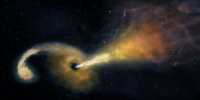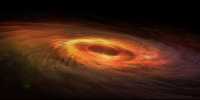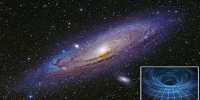Sergey Korsakov, a Russian cosmonaut, got a lovely shot of frost on the International Space Station’s glass (ISS). You could think it’s beautiful but not uncommon, yet it is. It’s possible that this is the first shot showing ice crystals developing on a spaceship window, and no one understands how they developed. The image depicts a crescent-shaped ice formation towering above the Earth, similar to that of Europa or Enceladus, our icy moons.
Korsakov posted the photograph on Twitter and Telegram in late May. The astronaut added on Telegram that the ice crystals were long-lasting, lasting over 24 hours, and that the condensation pattern remained even after they melted. Its creation, however, is unclear, and there appears to be little scholarly literature on the subject. When IFLScience contacted ISS members NASA, the European Space Agency (ESA), and the Japanese Space Agency (JAXA) for comment, all three declined to comment, citing the possibility that the window is in the Russian module of the ISS and that no one is speaking to Roscosmos.
We can only conjecture without that information. The ISS’s windows are made up of numerous panes, with the interior ones separated by air and the outward ones separated by vacuum. The ice crystals might be within the windows or on the station’s interior. Some speculate that the cosmonauts are breathing on the window, but the frost’s form (nearly perfect circle) and the ISS’s temperature rule it out. “The feature appears to have the most ice at the circle’s borders – this suggests the formation mechanism is acting equally from all sides, reaches a threshold to form ice at the circle edge, and then all water vapour is depleted before it gets to the middle,” said Dr. James Lea of the University of Liverpool.
“The ice crystals in the centre are becoming ice crystals and utilizing themselves to help expand out — they can’t travel outside the circle because it’s too warm.” A temperature differential in the glass might explain the round form, which is also perplexing. However, it would be dependent on the qualities of the windows, which are currently unknown.
“I believe the ice’s placement indicates a temperature gradient across the window. The contact point between the window and the hull of the space station at the window perimeter should be warmer than the contact point between the window and the hull of the space station at the window center.” Dr. Tom Whale of the University of Warwick, a specialist on the significance of ice nucleation in atmospheric science and cryobiology, told IFLScience.
“If there is a little amount of water vapour in the space between the window panes, or if there is a leak of relatively moist air from the space station into the hollow, ice may develop at the spot on the window where it becomes cold enough for ice to form, and then spread inward from there. The ice’s round form might be a reflection of the circular window design.”
While this riddle may never be answered, study on the formation of ice crystals in microgravity is ongoing. The JAXA has conducted studies on the production of ice crystals in space, revealing that “super” symmetry ice crystals may form in space. And as for Korsakov, it’s not the first time he’s captured something unusual from the ISS’s window…
















